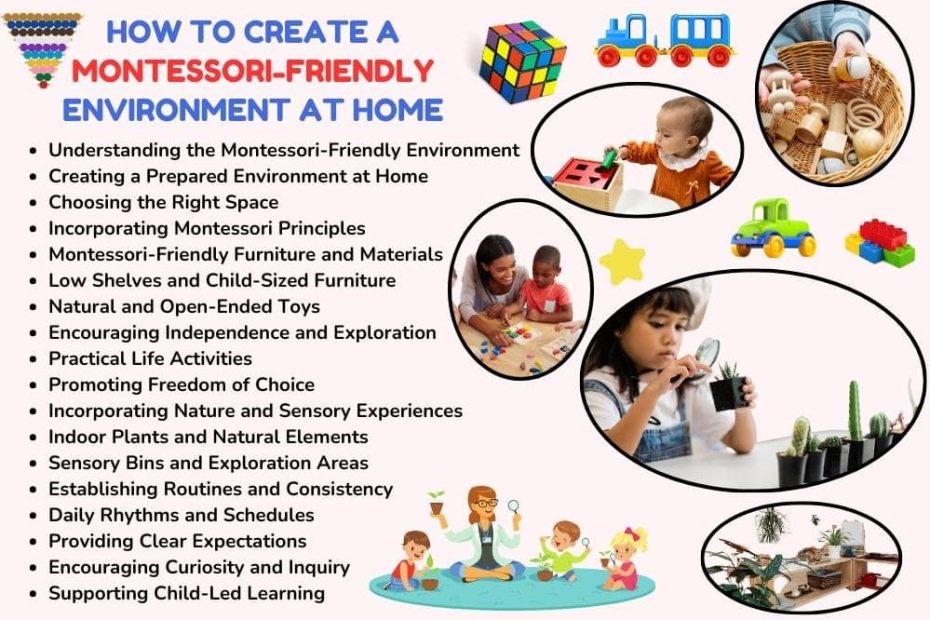Montessori education has gained significant popularity for its child-centered approach that fosters independence, creativity, and a love for learning. One of the key aspects of the Montessori Method is creating an environment that supports the child’s natural development. Whether you’re fully embracing Montessori principles or simply seeking to incorporate elements of it into your home, creating a Montessori-friendly environment can greatly benefit your child’s growth and development.
Understanding the Montessori-Friendly Environment
A Montessori-friendly environment is carefully designed to encourage self-directed learning and exploration. It is organized, orderly, and aesthetically pleasing, with materials and activities that cater to the child’s developmental needs and interests.
Creating a Prepared Environment at Home
To create a Montessori-friendly environment at home, start by designating a specific area or room that is dedicated to your child’s activities and exploration. Choose a space that is quiet, well-lit, and free from distractions, allowing your child to focus and engage fully in their learning experiences.
Choosing the Right Space
Consider the layout of your home and select a space that can be easily accessible to your child. Ideally, this area should be located away from high-traffic areas and should provide enough room for movement and exploration.
Incorporating Montessori Principles
Infuse the chosen space with Montessori principles by organizing it in a way that promotes independence and autonomy. Keep materials and activities within reach of your child, allowing them to freely choose what they want to work on and explore.
Montessori-Friendly Furniture and Materials
Invest in child-sized furniture and Montessori materials that are specifically designed to support your child’s independence and development. Low shelves, child-sized tables and chairs, and open-ended toys are essential components of a Montessori-friendly environment.
Low Shelves and Child-Sized Furniture
Arrange furniture and shelves at your child’s eye level, enabling them to easily access and return materials without assistance. This promotes a sense of ownership and responsibility, encouraging them to take an active role in their environment.
Natural and Open-Ended Toys
Opt for toys and materials that are made from natural materials such as wood, metal, and fabric. Avoid toys that are overly stimulating or have a predetermined purpose, as they may limit your child’s creativity and imagination.
Encouraging Independence and Exploration
Central to the Montessori philosophy is the belief in allowing children to do things for themselves and explore the world around them independently. Encourage your child to engage in practical life activities and provide opportunities for them to make choices and decisions on their own.
Practical Life Activities
Introduce practical life activities such as pouring, scooping, and sorting, which not only help develop fine motor skills but also instill a sense of competence and confidence in your child.
Promoting Freedom of Choice
Give your child the freedom to choose their activities and follow their interests. Provide a variety of materials and experiences for them to explore, allowing them to pursue their passions and discover new interests along the way.
Incorporating Nature and Sensory Experiences
Nature plays a vital role in a child’s development, offering endless opportunities for exploration and sensory experiences. Bring elements of nature into your home environment to stimulate your child’s senses and foster a deeper connection with the natural world.
Indoor Plants and Natural Elements
Introduce indoor plants, rocks, shells, and other natural elements into your home to create a calming and inviting atmosphere. Encourage your child to care for the plants and observe them as they grow and change over time.
Sensory Bins and Exploration Areas
Create sensory bins filled with materials such as rice, sand, water, and sensory balls, providing your child with tactile experiences that stimulate their senses and promote sensory exploration.
Establishing Routines and Consistency
Consistency and routine are essential for young children, providing them with a sense of security and predictability. Establish daily rhythms and schedules that include time for play, exploration, rest, and meals, helping your child feel grounded and supported.
Daily Rhythms and Schedules
Create a daily routine that aligns with your child’s natural rhythms and energy levels. Include ample time for free play, outdoor exploration, and quiet activities such as reading or drawing.
Providing Clear Expectations
Set clear expectations and boundaries for your child, guiding them in understanding what is expected of them in different situations. Be consistent in enforcing rules and consequences, while also allowing room for flexibility and understanding.
Encouraging Curiosity and Inquiry
Support your child’s natural curiosity and desire to learn by providing them with opportunities to explore new ideas, concepts, and interests. Encourage questions and discussions, and be actively engaged in their learning journey.
Supporting Child-Led Learning
Follow your child’s lead and interests, allowing them to take ownership of their learning experiences. Provide them with resources and materials that align with their interests, allowing them to dive deep into subjects that captivate their attention.
Summary
Creating a Montessori-friendly environment at home is a powerful way to support your child’s growth and development. By embracing Montessori principles and incorporating them into your home environment, you can provide your child with the freedom, independence, and opportunities they need to thrive.

